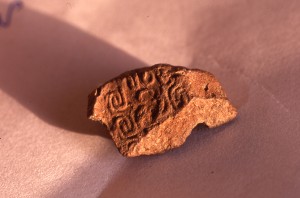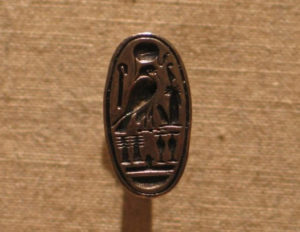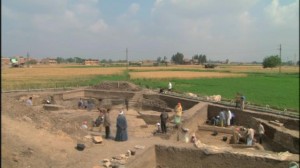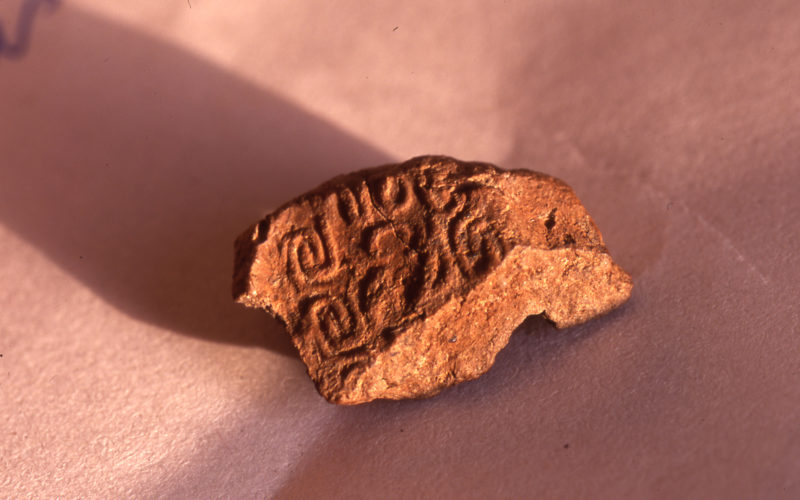Biblical Joseph’s Ring – Found!

Lately, my historical sleuthing has been focused on the Biblical Joseph – he of multi-coloured coat fame. Recently, I wrote a blog connecting the discovery of fragments of a monumental statue in Egypt with the Israelite patriarch Joseph. Now, I’d like to set the bar higher – I think we can identify Joseph’s royal ring. After more than 3700 years, you would think that finding a tiny ring in an Egyptian archaeological context would be impossible. As it turns out, finding it was less of a problem than identifying what it is. Understood historically, we can link a specific ring discovered in the Nile Delta with Joseph himself.
The story of Joseph is the longest, single narrative in the Torah (the five Books of Moses). It’s told in the Book of Genesis and it’s a tale of epic proportions. Joseph is one of the 12 sons of the patriarch “Jacob”, also called “Israel”. He is sold into slavery in Egypt by his jealous brothers and he is thrown into a dungeon, when he is falsely accused by his master’s wife of attempted rape. In prison, he meets up with some powerful Egyptian ministers who have run afoul of Pharaoh and he successfully deciphers their dreams. His dream decoding leads him to Pharaoh himself and, after successfully interpreting Pharaoh’s dreams, he is elevated to the status of a near Pharaoh. In Genesis 41:41-42 it states; “Pharaoh then formally declared to Joseph, ‘I am placing you in charge of the entire land of Egypt.’ Pharaoh took his ring off his own hand and placed it on the hand of Joseph.” It’s a Rags-to-Riches tale. But is it history? Moreover, can we find the ring?
We know for a fact, from both textual and archaeological evidence, that the rulers of Egypt were, indeed, called “Pharaohs”. We also know for a fact that they wore royal rings which were their seals. Meaning, other members of the ruling house and its administration wore those seals when they stamped documents in the name of Pharaoh. Furthermore, we know what these seals looked like and what they had inscribed on them. Basically, they attested to the divinity of Pharaoh. They established his divinity by claiming that he was a son of god i.e., the son of this or that particular god. So, for example, Rameses means the “son” of the sun god “Ra”.

So it seems that the Biblical narrative, whereby the ring is placed on Joseph’s finger, is consistent with history and archaeology, in the sense that such rulers did wear royal rings of authority.
But if such a ring was placed on Joseph’s finger it would have created an immediate theological problem for Joseph. After all, he was a monotheist. Monotheism is, by definition, exclusive. It does not allow for the celebration of other gods. Put simply, wearing the ring attesting to the divinity of Pharaoh would have been a huge problem for Joseph. It would be tantamount to idolatry.
So what do you do if you are Joseph? You either quit your job or you have another ring designed that is, monotheistically speaking, “kosher”. Among the Egyptians, the purpose of the ring was to deify Pharaoh, but for Joseph the purpose of any ring would have been to celebrate God. More than this, pharaohs denied their earthly fathers and celebrated their heavenly “fathers”. In contrast, Joseph would have wanted to celebrate his earthly father i.e., Jacob, by proclaiming Jacob’s exalted status as the chosen one of God. Put simply, Egyptian pharaohs celebrated themselves as sons of god, Joseph would have celebrated himself as the son of a human chosen by the one and true God.
Is there any tradition in the Biblical or rabbinic literature treating Jacob in this “chosen one of God” way?
In fact there is. In Genesis 49:24 it refers to God as “the Mighty One of Jacob”. In the Babylonian Talmud (b. Sota 36b.) the rabbis slightly shift the emphasis when referring specifically to Joseph. There, they called Joseph’s father, “the Mighty One, Jacob”. In other words, the Biblical tradition refers to Jacob in near divine terms and declares that he is God’s chosen one. In Genesis 47:10, it is Jacob that blesses Pharaoh and not the other way around. This idea is encapsulated in a formula that is still repeated everyday in the Jewish prayer service. It’s a quote from Psalms 135:4. The formula is “God selected Jacob as his Own, Israel as His treasure”. In Hebrew – and this is very, very important – the first part of the formula is stated this way; “Yakob (i.e., Jacob) Bahar (i.e., He chose)”. In other words, if you were the Biblical Joseph, you would not declare yourself to be a “son of God”, but a son of Jacob who is “chosen by God”. You would then have only one formula available to you: “Yakob Bahar”.
In Egyptian inscription practices, when you were running out of space and you had the same letter ending one word and beginning another, you could save space by writing that letter once. Given the minimal space available on a ring, what we would expect to find on Joseph’s royal ring is the term “Yakob Har” with the “b” serving as the last letter in “Yakob” and the first letter in “Bahar”. The “a’s” and the “o” wouldn’t be there because Hebrew doesn’t have vowels, only consonants. So, to sum up, the Book of Genesis says that when Joseph was raised to Pharaoh-like status, Pharaoh put a royal signet ring on his hand. The Biblical and rabbinic texts give us a formula for what that ring might state: “Ykb Hr”.
In my previous blog on the subject, I argued that the Hyksos capital Avaris was probably named after Joseph. In any event, the first century Jewish historian Josephus says that, at the time of Joseph, there was a Semitic people called “Hyksos” ruling Egypt’s Nile Delta. He identifies the Hyksos with the Israelites. For over four decades, Professor Manfried Bietak has been digging at Avaris. It is there that he found a statue that may very well be linked to Joseph. The question is; has Professor Bietak found any royal signet rings? And the answer is, yes! What is inscribed on them: “Ykb Hr”!

Hasn’t anyone noticed? I mean, after all, this is the only time that the name of the Israelite patriarch is inscribed on an Egyptian royal scarab. Well, in fact, scholars have noticed but they have chosen to dismiss the find. “Jacob,” they say, even though they have no evidence for this, was probably a common Canaanite name. “Hr”, they say, is probably a reference to a mountain (in Hebrew, “Har” means mountain). Since Canaanites worshipped the god Ba’al on mountain tops, they say, the ring probably refers to some Canaanite ruler who was into Ba’al. But this is, obviously, pure fantasy. The ring doesn’t mention Canaanites or Ba’al. Rather, it has inscribed on it exactly what we would expect the royal ring of Joseph to state: “Ykb Hr”!
Professor Bietak has found nine rings with Jacob’s name on them. They were probably worn by Joseph and his court officials. Here we have perfect synchronicity between the Biblical text and Egyptian archaeology. Joseph’s royal ring has been found in a 3700 year old archaeological haystack!
To see visuals of the find, see my documentary “The Exodus Decoded”.
Check out my latest blog in the Times of Israel: Statue of Biblical Joseph found: Story covered up!

